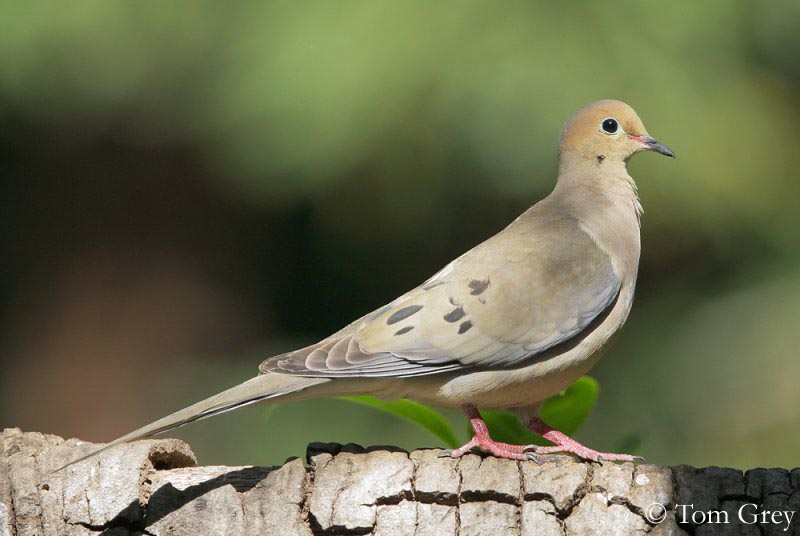
Mourning Dove
Zenaida macroura
Columbiforme Order – Columbidae family
BIOMETRICS:
Length: 23-34 cm ; Wingspan: 37-45 cm ; Weight: 86-170 g
LONGIVITY: up to 19 years
DESCRIPTION:
Mourning Dove is medium sized, brownish, with a pointed, white tipped tail. Males are larger than females and are slightly brighter coloured. Mourning Dove is a warm-coloured, cinnamon-brownish dove, with a long, graduated tail. On the ground, we can see large blackish spots on inner greater coverts and tertials, and small black mark on neck-side. Tail is dark brown with pointed tip. Legs are reddish.

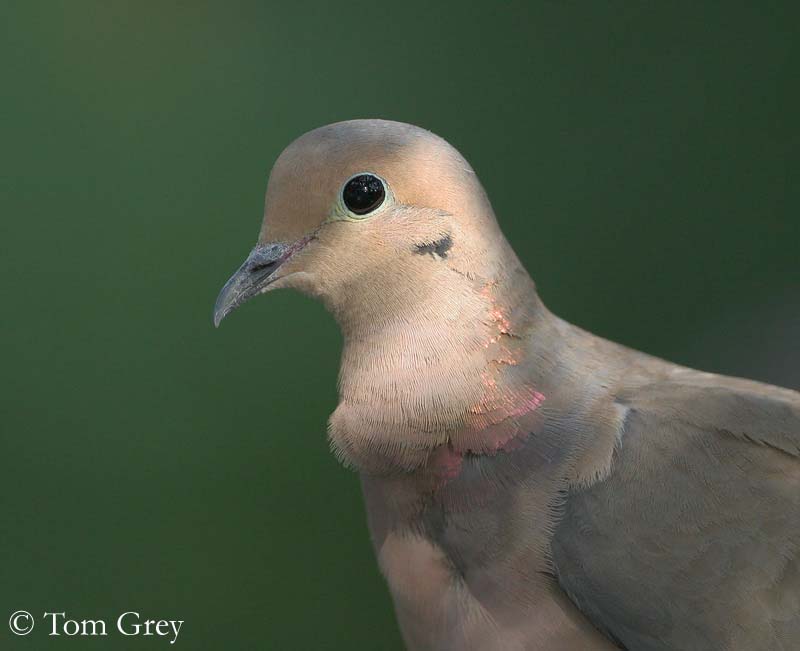
It has a purple and green iridescence on neck. The bill is black, very thin and delicate. The eyes show a bluish eye-ring of bare skin.
Sexes are similar, but male is slightly larger than female, and more colourful, with bluish crown and pink chest.
Juvenile is greyer and heavily speckled on wings and breast, but lacks neck patch.
VOICE: SOUNDS BY XENO-CANTO
Advertising call is a mournful “oowoo-woo-woo-woo”. Wings produce a fluttering whistle as the bird takes flight.
HABITAT:
Mourning Dove frequents farms, small towns, open woodlands, scrubs, roadsides and grasslands, parks and large gardens.
RANGE:
Mourning Doves may be found from Alaska and Southern Canada to Panama. They basically cover all of North America and most of South Africa.
BEHAVIOUR:
Mourning Dove feeds on ground in open country, and near habitations. Outside of breeding season, Mourning Dove lives and roosts in flocks.
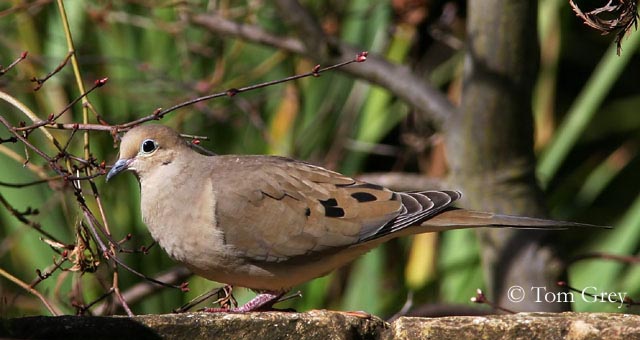
They are monogamous, and they have an elaborated courtship display. Male walks towards female, or pursues it, fluffing its feathers, and singing. Male performs flights displays too, flapping wings noisily, or gliding.
Mourning Dove has a widespread migration patterns. Migration begins in the breeding grounds, and continues to the southern areas to go to escape the harsh winter months. The birds can fly over 1000 of miles through hostile environment, to reach their winter resting spot.
FLIGHT:
Mourning Dove shows its long tail and white tips on outer tail feathers in flight. When disturbed, it bursts into strong, rapid flight on whistling wings. It has a strong, powerful flight.
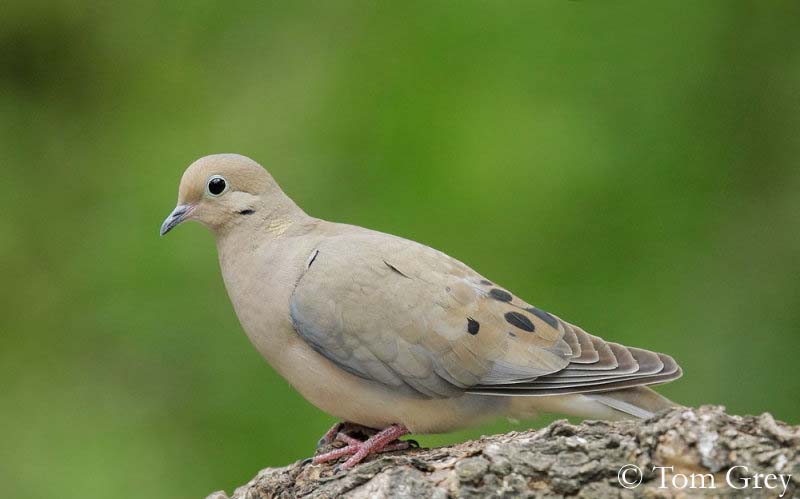
REPRODUCTION:
After finding a mate, Mourning Dove male initiates the nest selection site. Nest construction takes over 10 hours on 3 or 4 days. The nest is a poor built platform in shrubs, trees, vines, on about 15 feet above the ground. The male delivers nesting materials to the female, which builds the nest. He stands on her back and offers her sticks and twigs, which she incorporates into a bowl around herself.
The female lays 2 small, white eggs in the open nest. Incubation lasts 14 to 15 days. Both male and female share incubation and feed the young. Both parents regurgitate crop milk (pigeon milk) to the young birds. After five days, seeds are added to their diet. The young fledge at about 15 days, but parental feeding continues for up 12 days after fledging.
DIET:
Mourning Dove eats a wide variety of seeds, grains, fruits and insects. It prefers seeds that rest on the ground, waste grains.
When the ground foods have become scarce, they eat in trees or bushes. Most of their diet includes seeds or plant parts. They eat also agricultural crops, with cereal grains, such as corn, millet, rye, barley and oats. Occasionally, they prey on grasshoppers, beetles and snails.
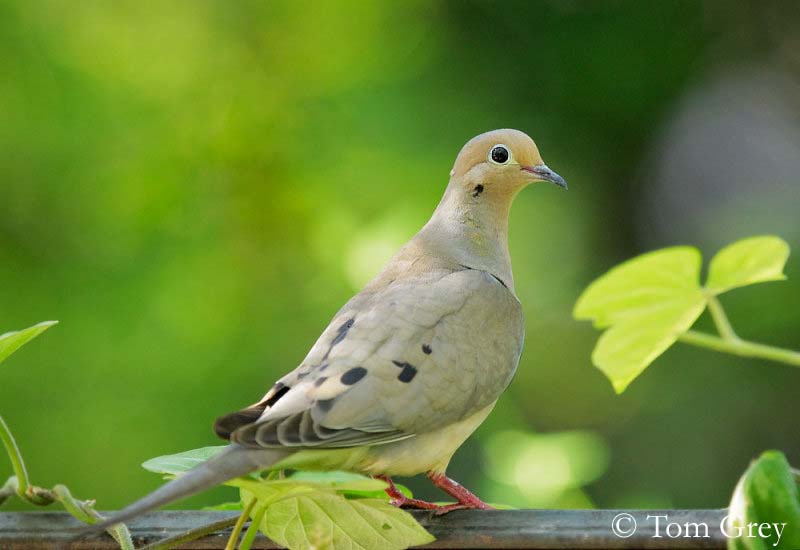
PROTECTION / THREATS / STATUS:
Mourning Dove is the most hunted game bird in North America. Approximately, 70 millions birds are killed annually (15 % of the fall population).
Populations are important. Fragmentation of forests to agricultural lands is a good advantage for them.
Mourning Dove has some predators, such as raptors (birds of prey), and raccoons, cats, dogs, snakes, squirrels and humans.
Fr: Tourterelle triste
All : Carolinataube
Esp : Zenaida Huilota
Ital: Tortora lamentosa americana
Nd: Treurduif
Russe: Плачущая горлица
Sd: Spetsstjärtad duva
Photographs by Tom Grey
His website:
Tom Grey's Bird Pictures
Text by Nicole Bouglouan
Sources:
HANDBOOK OF THE BIRDS OF THE WORLD vol 4 by Josep del Hoyo-Andrew Elliott-Jordi Sargatal - Lynx Edicions - ISBN: 8487334229
PIGEONS AND DOVES by David Gibbs, Eustace Barnes and John Cox - Pica Press Sussex - ISBN: 1873403607
FIELD GUIDE TO THE BIRDS OF NORTH AMERICA - National Geographic Society - ISBN: 0792274512
All About Birds (Cornell Lab of Ornithology)
Animal Diversity Web (University of Michigan Museum of Zoology)
Wikipedia (Wikipedia, The Free Encyclopedia)
What Bird-The ultimate Bird Guide (Mitchell Waite)
Bird Web (Seattle Audubon Society)